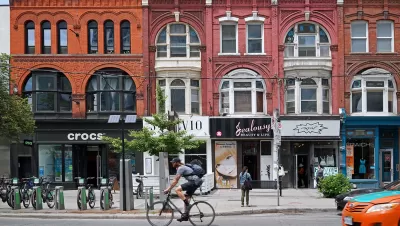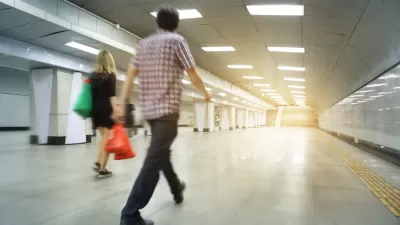It was clear to the City of Toronto that engaging less confident cyclists that make up 60% of the population, yet seldom come to community meetings, might be the key to dramatic mode shifts in the city. Here's how it happened.

One of my favorite tasks is interviewing clients to prepare a case study. It’s fun to hear their perspective, and sometimes a great story like this one emerges. This story highlights an unexpected outcome of community engagement for a cycling plan that reminds us in a powerful way about the importance of reaching the broadest audience possible. It also serves as a warning about how easy it is to be steered off course when your community engagement is dominated by a minority with strong opinions.
While many agencies are motivated to engage a diverse audience by regulations or politics, it's becoming increasingly clear that the successful implementation of plans often hinges on the views of some of the most historically underrepresented residents. The City of Toronto's recent approval of the landmark Ten Year Cycling Network Plan, which will double spending on cycling for ten years, powerfully proves the value of broad public participation.
It might surprise many that traffic congestion in Canada's largest city ranks among the worst in North America. Like many congested metropolitan areas, transportation planners are looking to encourage cycling as a cost-effective and healthy way to ease congestion.
As the city embarked on the development of the cycling plan, it was clear to the project team that broad engagement would be critical to unveiling insights that could lead to dramatic mode shifts. Historically, community engagement on cycling issues attracts primarily avid cyclists and angry anti-cycling critics. The result is often a highly polarized debate between people with entrenched and relatively extreme views.
The most important audience is also one that is historically underrepresented. To dramatically increase cycling and reduce traffic congestion, the team needed to hear from less confident cyclists who make up 60% of the population to understand what infrastructure would make them feel safe and comfortable.
A Blend of High Tech and High Touch Engagement
The City of Toronto and the IBI Group collaboratively developed the multi-faceted consultation approach to the Ten Year Cycling Network Plan. The results were impressive with 10,500 survey respondents. They blended innovative digital and face to face engagement strategies, including an interactive online survey using MetroQuest that engaged over 7,000 residents and collected over 300,000 data points, eight outdoor events on popular cycling routes, 12 stakeholder workshops, six rides led by staff to investigate neighborhood opportunities, and over 90,000 trips captured by the city's Cycling App (full disclosure - I'm the co-founder of MetroQuest hence the reason for my interviews with the project team that led to this story in the first place).
The massive reach of the community engagement was useful beyond political sound bites. It allowed the project team to understand the opinions of different demographic groups, even the ones that are traditionally missing. Jason Diceman, senior public consultation coordinator at the City of Toronto, played a key role in the community outreach on the project. Diceman states, "Collecting opinions from a mass audience empowered us to filter the data to see the opinions of less confident cyclists. While these respondents were a small minority of the overall responses, they represented a majority of our residents."
While confident cyclists typically only represent 1% of a given population, people who occasionally cycle because they are "interested but concerned" about their safety in traffic may represent 60% of the population. The risk of an inaccessible or too-narrow public consultation approach comes from vastly under-representing the voice of this majority.
The accessibility of the digital engagement was particularly important in reaching a broad audience and, in particular, less confident cyclists. As Christina Bouchard, City of Toronto planner who led the project, states, "Including a digital consultation component that residents could access from their own homes, according to their own schedule was more accessible to 'interested but concerned' riders than the typical public meeting at a community center. Outreach efforts that capture the voice of people who are less confident and only cycle occasionally can be particularly valuable, as they are the very people most likely to switch from driving to cycling if the conditions are right."

Beyond the sheer numbers, project leaders also commented on the importance of the quality and richness of the community input. As Bouchard states, "The digital survey and mapping tools in the MetroQuest software also allowed for the inclusion of more complex questions about neighborhood origins, destinations and desired lines. The wider base of input with aggregated mapping questions, which would have been difficult to ask using a standard written-word survey, provided an overall higher quality of feedback."
Some of the insights, particularly those from less confident cyclists, were surprising and revealed previously hidden preferences.
Key Insights From Community Input
Norma Moores, Project Manager with IBI Group led the consultant team for the project. With 30 years of experience designing and delivering transportation master plans and detailed designs for cycling infrastructure projects, she has overseen a wide range of public consultations. Moores explains, "Engagement options that are easily accessible to more moderate stakeholders, can impact the outcomes of a project design." In the past, highly engaged individuals who take the time to attend events are often cyclists predisposed to "vehicular style" cycling. They may be more comfortable mixing with motor vehicles and thus prefer network designs and facility types that support a more aggressive riding style on direct, busy streets. These confident riders typically have less interest in options on quiet local streets or separated facilities as part of the overall network design.
From a network design perspective, broader outreach in under-represented areas of the City of Toronto that are suburban in character, revealed that many families and occasional cyclists were supportive of off-street facilities that could be used for recreational cycling such as multi-use trails.
It’s useful to note that without careful consideration to the voices of the less confident cyclists, the results of the community engagement would have pointed to infrastructure suited to the 1% of the population who are already confident cyclists since they are highly engaged. Naturally it's important to meet the needs of confident cyclists. By also accommodating those on the fence, planners can open up a massive opportunity for change. The key lesson for planners is that, beyond cycling plans, it’s likely that this same danger affects all kinds of planning efforts.
The Shallow End of the Pool
A city without separated bike lanes and off-street cycling paths may be like a swimming pool with no shallow end. It's fine for confident swimmers but intimidating for novices. Surveys have found that bike ownership is the same in all parts of Toronto, however these bikes are ridden less often in suburban communities. When meeting with councilors, city staff were told that there was little support for painted bicycle lanes on streets. However, the feedback received as part of the Cycling Network Plan consultation suggested that the provision of separated facilities such as cycle tracks or trails could be more valued by a wider base of riders. As Bouchard states, "For these types of riders, the starting point may be tuning up their bike for a recreational ride. Now with a bike in ridable condition and after building confidence riding local trails, they become more likely to take a trip to the store and then perhaps to work."
To ensure delivery of the recommendations for each community in each of Toronto's 44 wards, a majority of councilors needed to approve a doubling of the budget allocated to the city's cycling program. The adoption of a broad, accessible and inclusive consultation effort ensured that sufficient residents were engaged in a majority of wards across the amalgamated mega-city. On June 9, 2016, the Toronto City Council adopted the plan, provisioning a doubling of the annual budget from $8 million to $16 million for cycling. This will connect, grow and renew Toronto's cycling network over the next ten years. The plan includes over 600 miles of new cycling network routes.
With the plan freshly minted, it's too soon to tell how successful these changes will be in motivating a significant shift towards biking. Over the next few years we'll be watching Toronto's progress carefully. You can follow along at the Toronto Cycling Network Plan website.
In the meantime, hopefully this story will motivate other cities to broaden the reach of their community engagement to reveal previously hidden opportunities for change.

Pennsylvania Mall Conversion Bill Passes House
If passed, the bill would promote the adaptive reuse of defunct commercial buildings.

Coming Soon to Ohio: The Largest Agrivoltaic Farm in the US
The ambitious 6,000-acre project will combine an 800-watt solar farm with crop and livestock production.

World's Largest Wildlife Overpass In the Works in Los Angeles County
Caltrans will soon close half of the 101 Freeway in order to continue construction of the Wallis Annenberg Wildlife Crossing near Agoura Hills in Los Angeles County.

California Grid Runs on 100% Renewable Energy for Over 9 Hours
The state’s energy grid was entirely powered by clean energy for some portion of the day on 37 out of the last 45 days.

New Forecasting Tool Aims to Reduce Heat-Related Deaths
Two federal agencies launched a new, easy-to-use, color-coded heat warning system that combines meteorological and medical risk factors.

AI Traffic Management Comes to Dallas-Fort Worth
Several Texas cities are using an AI-powered platform called NoTraffic to help manage traffic signals to increase safety and improve traffic flow.
City of Costa Mesa
Licking County
Barrett Planning Group LLC
HUD's Office of Policy Development and Research
Mpact Transit + Community
HUD's Office of Policy Development and Research
Tufts University, Department of Urban and Environmental Policy & Planning
City of Universal City TX
ULI Northwest Arkansas
Write for Planetizen
Urban Design for Planners 1: Software Tools
This six-course series explores essential urban design concepts using open source software and equips planners with the tools they need to participate fully in the urban design process.
Planning for Universal Design
Learn the tools for implementing Universal Design in planning regulations.



























